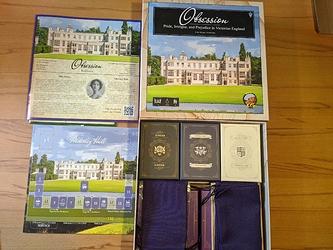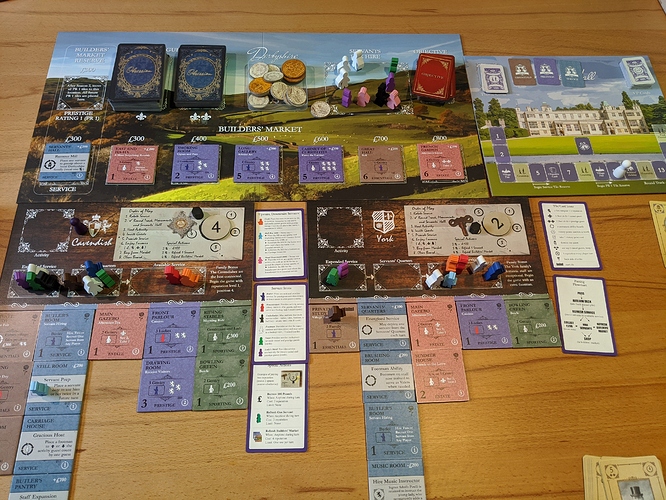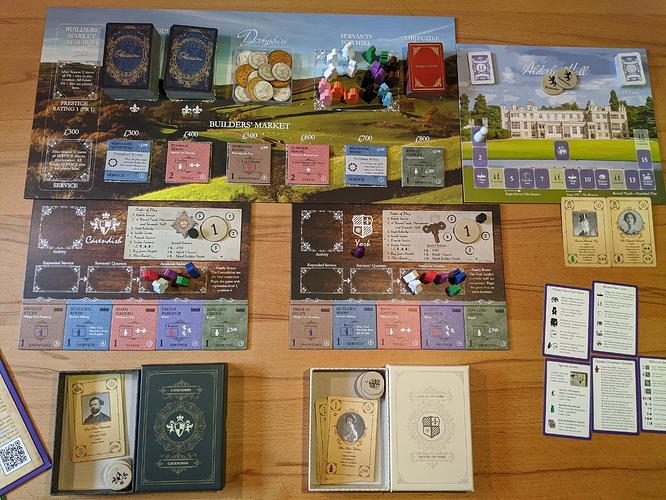I finally received my long-awaited KS copy of Obsession plus expansions. I just unboxed, learned and played a first game against myself (there is a solo mode but it is usually not wise to start out with that before knowing the basic rules).
Explanation and more pics inside
So this is the base game, two expansions & a bunch of promo tiles and cards from the three Kickstarters this game went through. One of the things that I appreciate very much is the attention to detail regarding the packaging. All of the game including the promo materials fit in the box in a neat an organized way. It was one of the major challenges the designer faced in the campaign because he very much wanted to achieve this. With a final weight of 3.7kg in a normal sized game box, you can imagine the complexity of the task.
There are six little boxes per playable “family” so you can pull out starting materials quickly (one could even pre-setup a game with those. And two bigger boxes for the tiles and cards and meeples. The first expansion box (Wessex) fits inside the box as well and is used to hold the family boards. It’s just lovely and all of the materials are really high quality, the card stock is great, the cardboard for the tiles is nice and thick…
There is just one criticism I have of the materials: in sum there are two rulebooks, one glossary and a number of loose leaflets. This is not the only game facing that particular challenge but I wish there was something I could do about the Zettelwirtschaft.
The rulebook is well organized though and after an initial “OMG how will I ever learn this” hiccup, it proved to be quite good.
This is the table after about half of a standard game (there is an extended version and about half a dozen variants). The game plays 1-4 players (up to 6 with expansions) and with all the variants (one of which aims to reduce swingines and randomness) I am reasonably sure that it works at all those player counts.
The theme is match-making among Victorian era gentry in Derbyshire, England in the tradition of Jane Austen and other authors from the period. I feel that theme is very nicely integrated into the Euro game underneath. My plan was to play this with an afternoon tea with my girls group… obviously this will have to wait. My partner on the other hand is scowling audibly when I mention I’d like to play with him.
So here’s the starting setup:
The goal of the game is to win the VP salad to become the most prestigious family around and possibly marry on of the eligible Fairchild bachelor/ettes. VP are (mostly) obtained from improving the estate (buy tiles for money) and having a lot of guests over (the gentry cards) and having a great reputation.
At the start, each family gets an estate with one tile in each category (essentials, service, estate, prestige and sporting) and 5 servants (who all have slightly different abilities and your butler can hire more later). Each family has their four members in their gentry deck at the start and starts with their reputation in tatters.
Each round every family is putting on an activity (the tiles) to which they invite guests (the gentry cards, including the family) which have to be served by the servants (meeple workers). As a result of an activity the family receives favors both from the activity and the participants. Favors come in three varieties (most of the time): money, more gentry cards and prestige.
Once a tile was used for an activity it is flipped over to the “improved” side which often means more VP or the ability to host larger gatherings. And finally before ending their turn, the player can use their money buy a tile from the market.
The standard game lasts 16 rounds, 4 of which are courtship rounds (some kind intermediate scoring). So it’s more like 12 rounds with some rounds having special conditions like giving players bonus money, allowing to ignore prestige requirements or buying more than one tile. This keeps things interesting, serves (partly) as catch-up mechanism and helps with the game’s arc.
The action each player takes each round is just putting on that one activity, using workers as required and then counting out what favors were obtained and finally buying a single tile from the market. It’s quite simple but a lot of things want to be considered. Many actions and guests require a certain prestige and the complexity of the decision space is only rising with each round. What helps is that the rulebooks suggests that one wants to use each tile once at the most because using it again doesn’t give additional VP. So unless one has a great combo this shrinks the decision space back to reasonable.
There are several mechanisms that are used in giving the game an arc where the start is rather slow and it feels like one will never reach the heights of prestige necessary to invite the Dowager Countess Fairchild (who needs 7) and a few rounds later you’re having dinner parties with 8 guests and are wondering how you hit the prestige ceiling.
One thing the game lacks is player interaction. Besides competing for the Fairchilds and buying tiles from the market there are only two other mechanisms that mess with other players (stealing prestige or workers) and I didn’t use either in my test game. But this is an issue with many such games and I don’t mind at all.
After only a single game vs myself it is too early to give a final verdict. So far I am impressed with the flow of the game and I think it has potential to see the table because I feel I can teach the game easily and playing it is not incredibly complicated but it seems to have enough depth to keep players engaged. It drips with the theme… and yet the theme doesn’t get in the way of this having solid mechanics.


